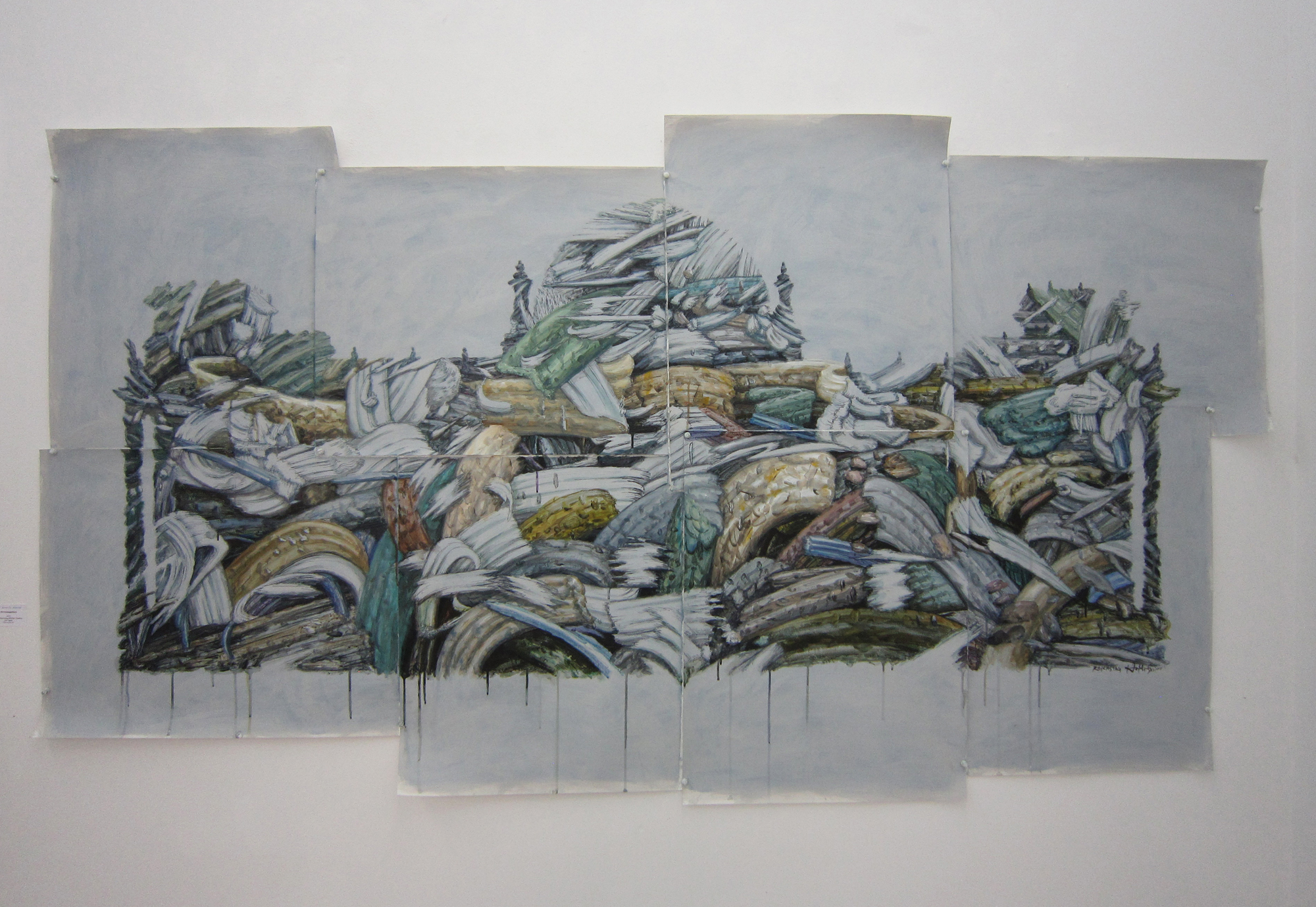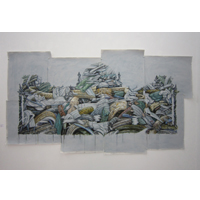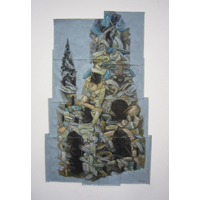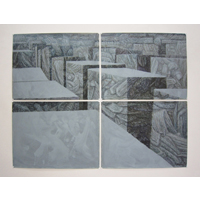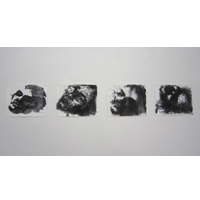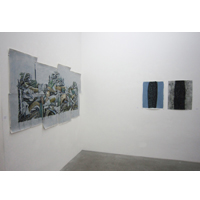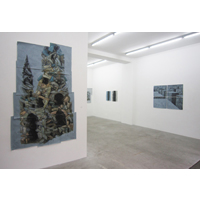Metastasis through Variations of Brush Strokes
Painting dwells on the canvas’ surface. The canvas’ surface or skin surface either informs the interior and exterior, or brings up a notional space. The surface of a painting is, thus, peculiar. While the conventional paintings of the Western world endlessly pursued the depth, it may be fair to state that modernism was compulsive to pursue a physical condition, flatness or planarity. On the other hand, the contemporary painting is rather focused on ‘surface.’ Unlike modernism, flatness or planarity in the contemporary painting leads a life near home within and outside the borderline. I reckon that the flatness simultaneously considers the layers of the both sides. In other words, it is the flatness or planarity is represented in various ways; and such diversity is expressed on the skin. Interestingly, there are some movements, which aim to achieve a new kind of painting-painting on painting, or to bear another possibility in meta-painting that surfaces conventional paintings. Surface is the necessary requirement for a painting. Individual understanding, imagination and interpretations on the surface, and brush strokes enable the visualization of such attempts. It is, thus, fair to state that painting is constantly reborn and newly called over. Ham Myung Su, too, summons the painting in the similar manner.
Ham Myung Su once wrote, “Ironically, I examine the inner and outer world at the threshold of painting, surface.” The term, ‘threshold of painting’ amuses me. The artist intends to embrace both sides of the world at the surface. Surface does not belong to either side; it rather belongs to both. It is impossible to go in or out in the painting; however, the painting’s surface has such depth and effects. A painting is made on a flat surface. Displaying how the flat surface is planned and worked-an artist’s unique sense and handlings of surface-is painting. In Ham Myung Su’s paintings, diverse variations on the surface is evident. Somewhat bizarre, humorous and unfamiliar they are, and they are from peculiar brush strokes of the artist. Brush strokes may suggest a certain object and they may even seem to reproduce it. As a matter of fact, however, brush strokes on their own stimulate some self-contained situations, textures, and senses. Initially, it seems that brush works were to delineate an object; gradually, brush works expose their own flesh escaping from a certain image. Still, these ‘odd’ touches-movements of a hand-render overall cityscapes. The usual, everyday cityscapes on a seemingly familiar flat canvas are now turned unusual. I am put to confront the surface, which has been believed familiar; the surface is now unordinary from aerial view, distorted images, atypical composition, incredible colors and textures created by absurd brush strokes. The cityscape in his painting seems reproduced as it is; at the same time, it becomes absurd and fictional. The painting solely made from brush works is an abstract painting; it is also illusionary as the multi-layer space, which covers the canvas space, creates the depth on the flat surface. Such illusionistic character is amplified as an artificially translated image of the world through human eyes is again processed by painstakingly analogue activity, painting. Moreover, it becomes even greater from the conflicts as the illusion-soaked world disturbing the laws of nature such as the law of gravity. Likewise, Ham Myung Su’s paintings cast the pleasure and humor from ‘alienating’ the world. He, with his brush strokes, taunts this gigantic city, our conventional thoughts and senses.
Meandering, streaming down, wriggling and swinging brushes rather than customary brush works applications: it is the physicality of a brush. The artist also expresses the trembling of his body. Overall, evenly applied winding brush strokes transmit the calligraphic rhythm and musical waves. It is almost as if you can hear the sound from a painting. Also, the brush works reminds of peculiar textures. Everything is covered with unaccustomed textures; hence, the world depicted in the painting seems even more bizarre. Transformation of the crust or the skin reverses familiar memories and learned experiences. On the canvas’ surface, surface or skin of everything is overthrown. Brush strokes, which normally bringing up images like hair, grass, noodles, etc., now replace exteriors of familiar objects. Strange textures throw us in confusion; it lets us look at the world once again creating the transformation of sense. While senses in the traditional paintings have been mostly about the retina-centrism, senses in Ham’s paintings are different sensory organs. The world stirring up the transformation! Tools he uses are color paints and slender brushes as traditional as ever; he creates surplus painting or over-do painting for too long a time with such traditional colors and brushes.
Ham Myung Su’s recent works are the cityscapes. Alleys and areas around his work studio and urban scape are rendered as the aerial panorama. Narrow alleys outside his studio, old shabby mom-and-pops, walls, tiny old houses back-to-back that reminds of hard and tiring lives-the views are drenched with the average lower middle classes in the city. To the contrast, glamorous, spectacular scenery of the city also unfolds. Urban panoramic view is much more dramatic and fierce. The light-emitting sense from a blaze of lights in the fascinating city is transferred onto the painting through his brush strokes. Personally speaking, recent works are more well-suited and compatible than his previous series. Also more dynamic and vivacious urban scape is much more dramatic and effective. His paintings are now much fancier: techniques more refined and stories in the paintings more interesting. However, it worries me with the thought that such refined paintings become too much stylized.
The artist first makes a sketch in detail with the pencil, roughly paints the contours, volume and shadows with the acrylic paints, then paints with the oil colors. Some parts of sketch drawings are exposed but left as they are; another trace is derived. He pumps out the fun and imagination throughout the process. Left out pieces of sketches create different scenes; his interest in different times, speeds, and movements are laid on top. Brush strokes on the canvas’ surface suddenly acquire the volume and space; the strokes become noodle or yarn-like. They are simultaneously concrete object and traces of bizarre objects with ceaseless brush works and many colors. It is somehow like the glow of firefly or the starlight; spots and color spreads are abrupt throughout the canvas surface driving the viewer’s eyes. Focusing on an object at one point, suddenly the interest shifts to brush strokes and colors, and then the cityscape catches the eyes. Painting is rooted in such dilemma between the two: it is image and object, surface and depth, and it is inside and outside.
Ham Myung Su’s painting leads us to contemplate upon the painting of which various textures on the flat surface brings variations, also upon the brush strokes that causes all kinds of transformations and variations on the flat surface. Brush strokes may be another metaphor of a body. Borrowing an object and transforming into different sensors and organisms are like inhabiting on the surface of other sensors. And is it not like the transformation of one’s body surface?
Park, Young-Taek (Professor at Kyunggi Univ., Art Critic)
An Artist’s Desire for Acts of Painting
Myung-Su Ham got on the flight to New York in December 2012. Whilst thinking about his trip, the image of Walter Benjamin who left to Moscow in December 1926 came across my mind. His Moscow Diary was written during his two-month stay in Moscow. He intensely depicted the scenes of the city where the fire of the revolution was still alive through the eyes of a stranger. Just like undivided paragraphs in Benjamin’s diary, Ham filled his canvases with the spectacles of the desire in the nightless city through his tenacious brushstrokes.
The most remarkable work among the recent works in this exhibition is the night scene of Times Square in New York. As New York City is filled with different races, it is the place of collision between various kinds of lifestyles and dynamics as well as dreams and frustration of contemporary individuals who live ruthlessly. New York is the symbolic city of capitalism and consumerism, and Times Square, crowded by 300,000 people on a daily basis, is the one of the most famous sightseeing spot with its flashy electric signs. The overflow of their glittering advertising images and the signs which are just big as movie screens offer excessive visual stimulations in order to drag out people’s desire to consume. The artist finds the city as a human avatar projecting their desires. After many photographs and drawings, he created oil paintings featuring the night view of New York using different-sized brushes. The city is represented with gigantic billboards and fiery electric signs like firecrackers, and the crowd on the street looks like ghosts who sold their soul. Also, the picture with running paints embodies the streets as virtual, phantasmal, and imaginary world.
Ham became known to public with Noodle Scape (2000) and it is crucial to talk about the ways of using brush strokes in Ham’s painting. What is the painting for Ham? “I tend not to struggle to realize a specific thinking on the canvas. I rather let the process of the painting lead me to think,” the artist states. I could see the traces of his long journey in the firm ways of painting when I visited his studio in Poongnap-dong, Seoul. The examples include Apple (2009) and Tunnel (2001) series reflecting the object with no separation between inside and outside; Candle (2004) series as the studies of flickering shapes of the candlelight; Cliff (2006) and Book (2009) series depicting layers of cliffs and books; Raindrops (2005) series illustrating falling raindrops; and the works representing ordinary objects such as shoes, hats and newspapers as natural landscape. These series of practices ultimately aim to understand the object and converse existing contexts in it. Observation enables the invisible visible. Good ways of seeing encourage one to realize fundamentals and logics in the world beyond the simple perception of its appearance. Skull (2008) series seen in this exhibition comprise senses of generation and extinction of life through his unique painting techniques symbolizing human and civilization.
The artist’s three major brush techniques are as follow: creating crumbling feel reminding one of knitting yarns or a crump of grass; hazy objects with quivering and falling expressions; and glossy brush strokes resembling the texture of metal by using big brushes. All of these construct the artist’s subjective landscapes by creating alternative images beyond substantiality of the objects. The objects ultimately become strange unseen subjects stimulating one’s tactual sense with their wiggling or guttering touch, enabled by the artist’s own tone and rhythm. Ham’s painting is also the artist’s battle against time. In order to create the flowing-like feel, he put thick layers of paints first and applies more layers with fine brushes before the first layer completely dries out. The paints overlapped in several layers naturally run and therefore the objects change their original forms and this progression creates the unique sense of rhythm and speed as it develops.
Ham’s obsession, compulsion and desire allow his hand to work without rest. For Ham, the painting perhaps presents his desire for play, lust, and pleasure came from the absence of unconsciousness.The human desire for consumption and the artist’s desire to paint altogether ooze through his paintings. Thus this solo exhibition by Myung-su Ham is landscapes of desire and remnants of pleasure-seeking in painting with the results of the artist’s intense preoccupation with painting from the past twenty years to today.
Jaehyun Kang(Curator at Savina Museum of Contemporary Art)







